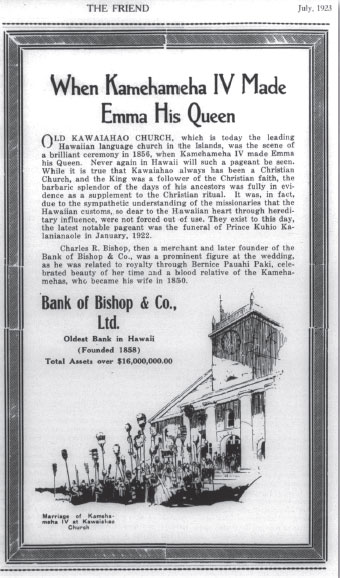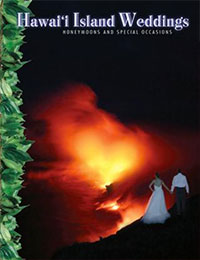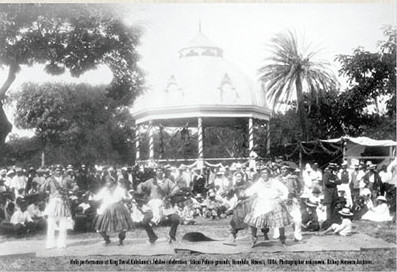A Royal Wedding
 One of the best documented royal weddings of Hawai‘i’s monarchy is that of Alexander Liholiho (King Kamehameha IV) and Emma Na‘ea Rooke. Their wedding captures the height of that romantic era in Hawai‘i’s history.
One of the best documented royal weddings of Hawai‘i’s monarchy is that of Alexander Liholiho (King Kamehameha IV) and Emma Na‘ea Rooke. Their wedding captures the height of that romantic era in Hawai‘i’s history.
On the morning of June 19, 1856, the Hawaiian government declared a public holiday. Honolulu’s streets were covered in rushes and grass to keep down the dust. Soldiers stood at attention, lining the street’s sides. Led by a cavalry escort, several carriages drove out in procession down King Street. One carried the bride and her three bridesmaids, Victoria Kamāmalu, Lydia Kamaka‘eha (who would later be known as Lili‘uokalani), and Mary Pitman. The other carriage bore the king, his brother, Lot, and their father, Kekūanao‘a. These royal carriages were flanked by kāhili bearers on foot, protecting the mana of their charges with the stately feathered emblems of rank. Uniformed aides-de-camp on horseback followed their king. The procession closed with more of the cavalry escort. The route was thronged with spectators, and a local newspaper noted that many of the Hawaiians, in a return to ancient custom, prostrated themselves as their chief passed by, “until their foreheads touched the ground.”
Arriving at Kawaiaha‘o Church, 500 people filled the building, and another 3,000 thronged outside. It was possibly the first recorded interdenominational wedding in Hawai‘i. The Anglican service was held in the Congregational church, where the Reverend Richard Armstrong performed it in Hawaiian and English.

As grooms have done before and since, the young king forgot the wedding ring. Fortunately, Chief Justice Elisha Allen quietly slipped his own gold band to the king, and the ceremony continued.
The bride’s Parisian wedding gown showed the influence of Queen Victoria’s choice of white, which had set the fashion world on end 16 years earlier. Since Victoria of England had worn her white satin and lace to marry Albert, anyone who was someone wanted white for her wedding. Emma’s elegant choice was of lustrous heavy white silk, trimmed with three richly embroidered flounces. Her veil of Brussels point lace was affixed to her hair by a garland of roses and orange blossoms. Her jewelry was a set of diamonds.
After the ceremony, the royal pair returned to the palace and were toasted by the Diplomatic and Consular Corps. That evening, a royal ball and supper was held at the palace for 500 invited guests. While the palace and its grounds were decked out in lights, the new queen shone more brightly in an evening dress of lace embroidered in white silk and silver. Marabou feathers completed the ethereal effect. The new Queen of Hawai‘i was also a queen of fashion!
At the end of the evening, fireworks from the summit of Puowaena (today known as Punchbowl) lit the night sky. Yet, the festivities were not over! The Americans, the Germans, and the Chinese business communities each gave a ball in honor of the royal couple, and the king reciprocated with yet another ball, which concluded the grand state festivities. Privately, Queen Emma’s parents, Dr. Rooke and his wife Grace, wishing to acknowledge those who had been part of Emma’s life, hosted a pā‘ina for their tenants, retainers, and household servants. At last, the royal couple was well and truly wed!
Written by Leilehua Yuen
